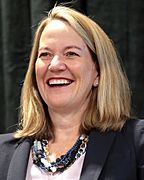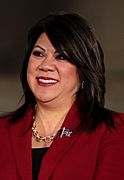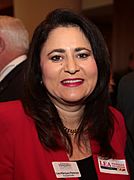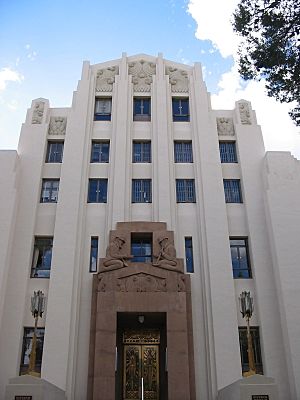Government of Arizona facts for kids
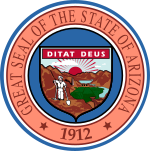
|
|
| Part of | United States of America |
|---|---|
| Constitution | Constitution of Arizona |
| Legislative branch | |
| Name | Legislature |
| Type | Bicameral |
| Meeting place | Arizona Capitol |
| Upper house | |
| Name | Senate |
| Presiding officer | Warren Petersen, President |
| Presiding officer | Steve Montenegro, Speaker |
| Executive branch | |
| Head of State and Government | |
| Title | Governor |
| Currently | Katie Hobbs |
| Appointer | Election |
| Cabinet | |
| Name | Cabinet |
| Leader | Governor |
| Deputy leader | Lieutenant Governor |
| Headquarters | State Capitol |
| Judicial branch | |
| Name | Judiciary of Arizona |
| Courts | Courts of Arizona |
| Supreme Court of Arizona | |
| Chief judge | Robert M. Brutinel |
| Seat | Phoenix, Arizona |
The government of Arizona is how the state of Arizona is run. It's set up by the Arizona Constitution and has three main parts:
- The executive branch, led by the Governor, which carries out the laws.
- The legislative branch, called the Arizona Legislature, which makes the laws.
- The judicial branch, which includes the Arizona Supreme Court and other courts, and interprets the laws.
Arizona also has local governments, like those for counties and cities.
Contents
Executive Branch
The executive branch is in charge of making sure the state's laws are followed. It includes the Governor and several other officials who are elected by the people of Arizona.
- Elected Executive Officials in Arizona
-
Katie Hobbs (D)
Governor
- Elected Corporation Commissioners
Most of these elected officials serve for four years. They can usually serve two terms in a row. For a long time, Arizona was one of the few states without a Lieutenant Governor. This meant the Secretary of State would take over if the Governor couldn't do their job.
However, in November 2022, voters approved a change. Starting with the 2026 elections, Arizona will have a Lieutenant Governor. This person will run for office alongside the Governor and will be next in line to become Governor if needed.
Governor's Cabinet
The Governor works with a team of leaders called the Cabinet. These leaders manage different state departments and agencies. Each department handles specific tasks to serve the people of Arizona.
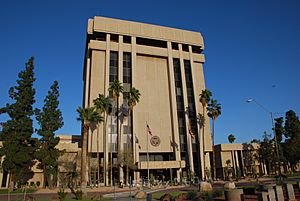
Some of the important state departments include:
- Arizona Department of Administration (ADOA) - Helps manage state government operations.
- Arizona Department of Corrections (ADC) - Manages state prisons.
- Arizona Department of Economic Security (DES) - Provides social services.
- Arizona Department of Education (ADE) - Oversees public schools.
- Arizona Game and Fish Department (AZGFD) - Manages wildlife and outdoor recreation.
- Arizona Department of Health Services (ADHS) - Works on public health.
- Arizona Department of Public Safety (DPS) - Is the state police force.
- Arizona Department of Transportation (ADOT) - Manages roads and transportation.
Legislative Branch
The Arizona State Legislature is the part of government that makes laws for the state. It has two parts, which is called bicameral:
- The Arizona House of Representatives, with 60 members.
- The Arizona Senate, with 30 members.
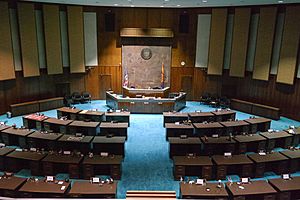
Each of Arizona's 30 legislative districts elects one Senator and two Representatives. These lawmakers serve two-year terms. They can serve up to four terms in a row in either the House or the Senate.
The Legislature meets every year. The main session starts in January and usually ends by late April or early May.
Judicial Branch
The judicial branch is responsible for interpreting the laws and making sure justice is served. It includes different levels of courts.
Arizona Courts
- Arizona Supreme Court: This is the highest court in Arizona. It has a Chief Justice and several other justices. They hear important cases, especially those involving the death penalty. They can also decide if a law goes against the state's constitution.
- Arizona Court of Appeals: This court handles appeals from lower courts. It's divided into two main parts, one in Phoenix and one in Tucson.
- Arizona Superior Court: This is the main trial court in Arizona. It handles a wide range of cases, from serious crimes to major civil disputes.
- Arizona justice courts: These courts handle smaller civil lawsuits, landlord-tenant issues, small claims, and traffic offenses like DUIs and minor crimes.
- Arizona municipal courts: Also known as city courts, these handle misdemeanor crimes and traffic cases that happen within a city or town. They also deal with violations of city rules.
How Judges Are Chosen
In Arizona, many judges and justices are chosen through a process called merit selection. This means they are not elected by voters in the usual way. Instead:
- A special commission suggests a list of qualified people to the Governor.
- The Governor then chooses a judge from that list.
- After a judge is appointed, voters decide if they should keep their job in a "retention election." This happens after their first two years, and then every four or six years after that, depending on the court.
This system is used for judges on the Arizona Supreme Court, the Court of Appeals, and trial court judges in the larger counties like Maricopa County, Pima County, and Pinal County.
Local Government
Arizona is divided into areas called counties. These counties get their power from the state government. Cities and towns in Arizona have their own local governments, usually led by a city or town council. These local governments handle things like local services, police, and fire departments.
See also
- Politics of Arizona
- Political party strength in Arizona
- Arizona Independent Redistricting Commission




